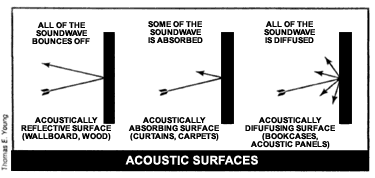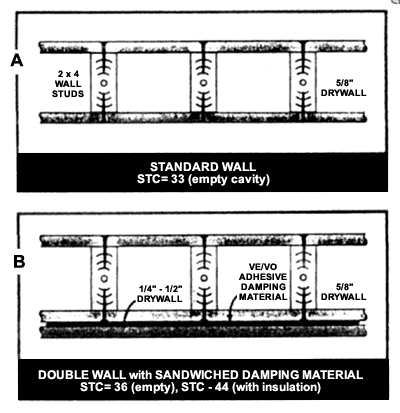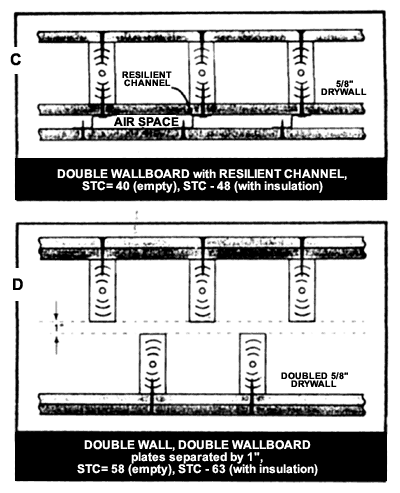




Room Acoustics Your decision is finally made, after weeks of reading reviews and driving from store to store, you finally decide on the speaker system that's going to make your home theater room come alive. It's a little more money than you wanted to spend, but your local dealer has offered you a deal that's hard to refuse. The next thing you know, you're back home pulling speakers out of cardboard boxes, and draping speaker cables all over the place. Finally, when all the connections are made, you plop yourself in the from row center seat, hit the play button and ...hey, wait, what's going on? Where's the center-channel detail you heard in the store? And where's that thundering bass? Welcome to the mysterious world of room acoustics. The reason your speakers sounded different in the dealer's demo room most likely had to do with the difference between the acoustic characteristics of his room versus yours. Audio experts have known for years that the physical attributes of listening rooms are every bit as important as the audio equipment involved. As a matter of fact, some would argue that room acoustics are far more important than popular equipment features such as gold connectors, polypropylene capacitors, and the like. Now don't get us wrong. It's not that these details are unimportant, it's just that room acoustics are far more important-and often overlooked. One of the first scientists to investigate the role of room acoustics in high-quality sound reproduction was Roy Allison. Allison's seminal research in this area was revolutionary and led to a new way of looking at speaker and equipment design. The basic premise is that the acoustic makeup of a listening room can play a significant role in the total system of sound reproduction. Allison explains: "The acoustic parameters of a room have a tremendous effect on the quality of sound you hear. The problem is that acoustics as a science is poorly understood by many audio enthusiasts. However, it should be known that one does not need a Ph.D. in the field to properly treat their own listening room; a few modest room treatments can go a long way. The only trick is knowing which ones are best to use." Back To School
Although the exact acoustic soundfield that occurs in an enclosed space can be quite complex, there are three components that predominate. The first is the direct sound from the speakers themselves. These are the soundwaves that travel in a straight line directly from the speaker drivers to the listener's ears. These direct sounds are considered the most significant component of sound reproduction because of their relatively large amplitude and transmission characteristics. But they're easy to deal with: All you need do is make sure you have an unencumbered line of sight from the speakers to your listening seat. Next are the first reflections. These are the sound waves that bounce off surfaces flanking the speakers and the listeners. As the diagram at left illustrates, these sounds typically bounce off nearby walls, the ceiling, and the floor. Acousticians feel that these early reflections are important to the perception of the soundstage. If you don't do something to attenuate these reflections, the soundstaging and imaging produced by your speakers will become less accurate. The last component is reverberation. Reverberation consists of the countless random reflections that bounce off other surfaces in the room and eventually arrive at the listener's ears. These sound reflections reinforce the feeling of room size and ambience. When you are in a large room with hard surfaces, such as a Gothic stone church, the reverberatory echoes bouncing off the stone walls are the components that give you that cavernous sonic experience. Listening Room Physics So how do these components affect your listening room? When you fire up your new home theater speaker system, all the sounds bouncing around the room combine to form a unique acoustic room signature. This signature effectively becomes superimposed on the primary recording and modifies it. It's almost as if there are two separate sound systems in the room playing at the same time. Acousticians agree that the best way to design a listening environment is to strive for sonic balance of these "systems." For example, you don't want an overemphasis on reverberated sound, or you'll feel like you're listening in a tiled bathroom. On the other hand, you don't want a room void of reflections, in which case the room will sound dead and lifeless. The ideal listening room allows some of the first reflections and some of the reverberatory components to arrive at the listener's ears, just enough of each to balance the resulting sound and make it sound natural. There are two ways to control the first reflections and room reverberations to achieve sonic balance: absorption and diffusion.
How to Do It There are dozens of methods and hundreds of products available to whip your listening room into shape. Rather than catalog all the products and techniques available, we will take a more pragmatic approach- we will consider each room surface individually and suggest appropriate treatments. First, let's look at the floor and ceiling surfaces. These can be the worst offenders in a listening room because they're often constructed of extremely reflective materials. The absorption coefficient, for example, of your standard plaster/gypsum-board ceiling is approximately 0.5 at 1 kHz. In other words, sounds bounce right off this stuff. And hardwood and tile floors aren't much better, with absorption coefficients at 1 kHz of .01 and .07, respectively. Fortunately, though, there is a standard household building material that soaks up soundwaves: carpeting. Both wall-to-wall carpeting and area rugs do a wonderful job of absorbing sound energy. And fortunately, carpeting goes quite well with most listening-room decors. Ceilings, however, can be more problematic. One could glue carpeting to the ceiling, but we doubt your interior decorator (read: spouse) would approve. The next best thing is to install acoustic ceiling tiles. The least expensive option is to use the standard 1 - by 1- foot, fiber-based, tongue-and-groove tiles sold by building supply stores. Typically, these are installed 12 inches on center, on 1-by 3-inch strapping that is firmly screwed into the ceiling joists. Properly installed, these fiber-based tiles actually do a pretty good job of absorbing soundwaves, particularly in the higher frequencies.
You can also consider the professional acoustic ceiling materials. Various companies sell materials that are decor-friendly and specifically designed for ceiling use. IIlbruck, for example, offers their famous Sonex panels, made from a new, Melamine absorptive foam. These panels are available in a number of different surface textures and a variety of colors. For those who are opposed to the commercial look of Sonex, there are plenty of flat-faced products available. These are typically constructed of fiberglass or foam materials. Acoustical Solutions, for example, offers a number of panels that can be applied to the ceiling. Their Alphasorb panels are constructed of fiberglass sheets wrapped with woven decorator fabrics and are offered in 65 different colors. Several companies also offer special ceiling diffusing panels. These panels come in a multitude of shapes and sizes, all designed with intricate diffusing surfaces. Listening-room walls often promote sonic misbehavior because they are typically constructed of hard substances such as gypsum board or wood. Since the wall surfaces located near the listener are directly involved in first reflection, it is especially important that they be addressed. For the economical approach, ordinary drapes can go a long way. You can also place furniture, plants, or other items in the way to diffuse the sound. For example, it's hard to beat an upholstered couch or chair for sound absorption. If you place an object like this right at the spot on the wall where first reflections occur, a remarkable improvement in sound can result. If these conventional wall-taming approaches are inconvenient, you can consider professional products. RPG Diffuser Systems, for example, offers the Acoustic Tools For Home Theater line. This line contains several panels that can be used to attenuate wall reflections. Armstrong also offers a line of decorator styled acoustic wall panels designed for easy installation. Their SoundSoak panels are available in many colors of woven fabric. Many audiophiles use a product called RoomTunes to tame their sidewall reflections. Michael Green Designs manufactures these tall, free-standing monolithic panels, which use a fiber filling with a Mylar diaphragm stretched across the front that reflects very high frequencies. They're designed to provide control of room acoustics without creating a "dead" sound. The company also makes a variety of other products designed for use in corners and other spots in the room. Even if you've toned down the reflections in the room by using ceiling panels, a carpet, and a couple of acoustic panels on your side walls, you may still need to do some work on the rest of the room, which will contribute to the reverberatory ambience. Amateur acousticians often test the reverberatory tendencies of a room by standing near the listener's position and clapping their hands together loudly. The resulting echo can tell you a lot about the sound signatures of the room. If the clap produces a distinct echo, you probably have some surfaces that need to be toned down. Generally, the main offender is the rear wall. If it is flat and open, you should consider some treatments. As in the other surfaces, this does not always necessitate professional products. Bookcases, pictures, drapes, and other common household furnishings can absorb and diffuse the sound energy quite well. The last issue to consider is standing waves. Standing waves occur when lower-frequency sounds bounce off opposing walls and combine to produce unnatural sounding peaks or dips in the bass response. First of all, unless your room has large areas of opposing surfaces, this may not be a problem. However, if your room is stark, standing waves could occur. Absorptive is the technique of choice here. One of the best ways to soak up standing waves is with furniture; plushly upholstered seating does a great job. If you want to get fancier, several manufacturers offer high-tech professional approaches. One of the best known is Acoustic Sciences Corporation's Tube Traps, which are designed to reduce standing waves. These devices are tall, free-standing cylinders that are designed to absorb specific sound frequencies. Half sections are available to hang on the wall; these might be the best option where large expanses of hard surfaces exist. These tubes are available in a wide variety of shapes and sizes. Feel Free To Experiment Now that you have an understanding of the techniques involved, tuning your home theater room for spectacular sound be straightforward, right? Well maybe not. We asked Jay Trieber, the president of Home Theater Concepts, a home theater design firm, based in Norwood, Massachusetts, for his thoughts. "We use all the standard acoustic treatments," Trieber explains, "but the problem is that home theater rooms can be very complex acoustically. Each room is unique, and techniques that work well in one room may not work in others. What we recommend is that you work on known problem areas, such as hardwood floors, first. If further treatment is necessary, take it a step at a time and experiment. The proof is what you hear - let your ears be the final judge."
|



